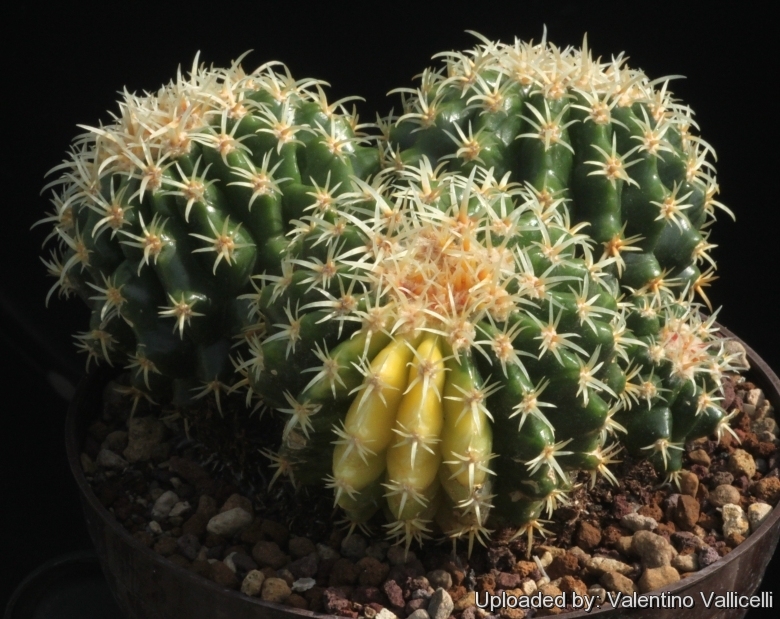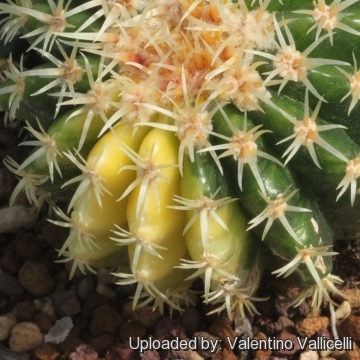
Echinocactus grusonii var. intermedius f. variegatus Photo by: Valentino Vallicelli
Origin and Habitat: Garden origin (Nursery produced cultivar)
Synonyms:
See all synonyms of Echinocactus grusonii
Description: This is an eye-catching variegated cactus that always make a spectacular attraction. This plant differs from the common Golden barrel cactus (Echinocactus grusoniiSN|3345]]SN|3345]]) for the spines that are stout but intermediate in length between the standard from and the short spined type "brevispinus". The variegated plants have yellow sectors that contrasts nicely with the normal green epidermis.
Habit: Except for the spines it is identical in shape and size to the standard species.
Stem: Single, slowly growing, heavily ribbed, globe-shaped becaming elongated (barrel-shaped) in maturity, green with yellow variegation, up to 90 cm (180 cm) in height and spread. They normally offset with advanced age and a few multiples occur even at small sizes.
Areoles: Numerous, closely set the becomes almost adjacent at maturity.
Spines: Yellow, intermediate in length between the standard from and the short spined type "subinermis" (syn. brevispinus), stout, spreading and nicely curved toward the body.
Flowers: Flower are diurnal, vivid yellow (4-5 cm wide) and form a circular ring at the top of the plant, but are not very visible being small in relation with the size of the barrel, and lost into the creamy coloured wool at the plant apex.
Blooming season: The flowers are produced from end of spring to summer only on larger mature specimens receiving enough full sun.
Subspecies, varieties, forms and cultivars of plants belonging to the Echinocactus grusonii group
 Echinocactus grusonii Hildm.: It produces slowly growing barrel-shaped stem up to 90 cm (180 cm) in height and spread. The stem is pale green and heavily ribbed with very numerous areoles and golden yellow spines.
Echinocactus grusonii Hildm.: It produces slowly growing barrel-shaped stem up to 90 cm (180 cm) in height and spread. The stem is pale green and heavily ribbed with very numerous areoles and golden yellow spines. Echinocactus grusonii var. albispinus Y.Itô: It looks just like a regular "Golden Barrel" but the spines are glassy-white instead of yellow.
Echinocactus grusonii var. albispinus Y.Itô: It looks just like a regular "Golden Barrel" but the spines are glassy-white instead of yellow. Echinocactus grusonii var. albispinus f. cristatus hort.: crested form with spines all white instead of yellow.
Echinocactus grusonii var. albispinus f. cristatus hort.: crested form with spines all white instead of yellow. Echinocactus grusonii f. cristatus hort.: This is a wavy crested form with golden-yellow spines. It can also get very big making a spectacular specimen.
Echinocactus grusonii f. cristatus hort.: This is a wavy crested form with golden-yellow spines. It can also get very big making a spectacular specimen. Echinocactus grusonii var. intermedius hort.: This plant differs from the common Golden Barrel Cactus for the spines that are stout but intermediate in length between the standard from and the short spined type "subinermis" (syn: brevispinus).
Echinocactus grusonii var. intermedius hort.: This plant differs from the common Golden Barrel Cactus for the spines that are stout but intermediate in length between the standard from and the short spined type "subinermis" (syn: brevispinus).- Echinocactus grusonii var. intermedius f. cristatus hort.: Strong crested form with stout spines that are intermediate in length between the standard from and the short spined type "subinermis" (syn. brevispinus).
 Echinocactus grusonii var. intermedius f. variegatus hort.: Yellow and green, variegated plants with short, spines that are intermediate in length between the standard from and the short spined type "subinermis" (syn. brevispinus).
Echinocactus grusonii var. intermedius f. variegatus hort.: Yellow and green, variegated plants with short, spines that are intermediate in length between the standard from and the short spined type "subinermis" (syn. brevispinus). Echinocactus grusonii var. intertextus Y.Itô: (a.k.a "Krauskopf" or "tortulispinus") This plant differs from the common Golden barrel cactus for the spines, that are yellowish-white, sparse, flattish, curved to almost crinkled backward and very irregular, 2 to 6 cm long.
Echinocactus grusonii var. intertextus Y.Itô: (a.k.a "Krauskopf" or "tortulispinus") This plant differs from the common Golden barrel cactus for the spines, that are yellowish-white, sparse, flattish, curved to almost crinkled backward and very irregular, 2 to 6 cm long. Echinocactus grusonii var. intertextus f. cristatus hort.: Crested form with characteristich curved spines, that are flattish, almost crinkled backward and very irregular.
Echinocactus grusonii var. intertextus f. cristatus hort.: Crested form with characteristich curved spines, that are flattish, almost crinkled backward and very irregular. Echinocactus grusonii f. monstruosus cristatus hort.: Crested form of the mostrose cultivar covered by white wool with short yellow spines. The crests are quite unstable
Echinocactus grusonii f. monstruosus cristatus hort.: Crested form of the mostrose cultivar covered by white wool with short yellow spines. The crests are quite unstable Echinocactus grusonii f. monstruosus hort.: Free offsetting small form covered by yellowhish-white wool with short yellow spines. The rib structure is not yet apparent, and they have pronounced tubercles making them look superficially like Mammillarias.
Echinocactus grusonii f. monstruosus hort.: Free offsetting small form covered by yellowhish-white wool with short yellow spines. The rib structure is not yet apparent, and they have pronounced tubercles making them look superficially like Mammillarias. Echinocactus grusonii var. setispinus f. minor cristatus hort.: This is the tiniest crested form. A dwarf form covered by touch friendly spines and looking quite dissimilar to the standard species.
Echinocactus grusonii var. setispinus f. minor cristatus hort.: This is the tiniest crested form. A dwarf form covered by touch friendly spines and looking quite dissimilar to the standard species. Echinocactus grusonii var. setispinus f. minor mostruosus cristatus cv. Scarascia: The plant forms lots of tiny monstrous wooly heads, that time by time begin to crest.
Echinocactus grusonii var. setispinus f. minor mostruosus cristatus cv. Scarascia: The plant forms lots of tiny monstrous wooly heads, that time by time begin to crest. Echinocactus grusonii f. setispinus hort.: This cultivar has very thin acicular spines, that become longer as the plant ages.
Echinocactus grusonii f. setispinus hort.: This cultivar has very thin acicular spines, that become longer as the plant ages. Echinocactus grusonii var. subinermis Y.Itô: (a.k.a. "cv. TOGENASHI KINSHACHI", "inermis" or "brevispinus") This is very short spined mutantant. Except for the spines it is identical in shape and size to the standard species.
Echinocactus grusonii var. subinermis Y.Itô: (a.k.a. "cv. TOGENASHI KINSHACHI", "inermis" or "brevispinus") This is very short spined mutantant. Except for the spines it is identical in shape and size to the standard species. Echinocactus grusonii var. subinermis f. cristata hort.: This is the crested form of the short-spined Golden Barrel. This crest can also get very large
Echinocactus grusonii var. subinermis f. cristata hort.: This is the crested form of the short-spined Golden Barrel. This crest can also get very large
Notes: A variegated plant has sectors, patches or stripes with two or more different colours, even distinct shades of green. Plants with variegated stems or leaves are often attractive and highly prized. In most species the stems or leaves are normally green, and variegated epidermis is an uncommon mutation, termed a chimera. A chimeral variegation is due to losing the ability to produce chlorophyll in some of the plant’s tissue, so that this tissue is no longer green. Tissues lacking chlorophyll are usually white or pale yellow coloured (due to carotenoid pigments) or red (due to betalain or anthocyanin pigments) contrasting with the normal green tissue. There are several forms of variegation, depending on the tissues that have been affected. The variegation in some forms is unstable. The extent and nature of the variegation can vary, and sometimes the plant will return to the green form. In others it is stable and does not change under normal conditions. Because the variegation is due to the presence of two kinds of plant tissue, propagating the plant must be by a vegetative method of propagation that preserves both types of tissue in relation to each other.
 Echinocactus grusonii var. intermedius f. variegatus Photo by: Valentino Vallicelli
Echinocactus grusonii var. intermedius f. variegatus Photo by: Valentino VallicelliSend a photo of this plant.The gallery now contains thousands of pictures, however it is possible to do even more. We are, of course, seeking photos of species not yet shown in the gallery but not only that, we are also looking for better pictures than those already present.
Read More... Cultivation and Propagation: This variegated form of Echinocactus is regarded as choice and rare in cultivation. It cannot tolerate prolonged exposure to direct sun light (especially during the hottest summer days), so grow it in half-shade or under filtered sun. It is often seen as grafted plant, but may grow well on its own roots, too. Use mineral well-permeable substratum with little organic matter (peat, humus). Water sparingly from March till October and keep perfectly dry in winter at temperatures from 5 to 10 degrees centigrade. (In general these plants are more tender and cannot endure freezing temperatures ) In the rest period no high atmospheric humidity!!
Propagation: Cuttings or grafting onto column-shaped cacti, unpredictably a very few variegated plants appear among normal seedling.











